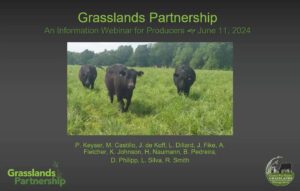Overview for Interested Producers
Producers interested in implementing grasslands management practices supported by the Grasslands Partnership should consult this overview that describes how enrolled producers engage with an Extension contact, the first step in enrolling as a Producer-partner in Grasslands Partnership.
Supported Grasslands Practices
Producers who participate implement these practices. Producers are strongly encouraged to adopt three practices. Extension contacts will assist producers in determining which practices fit with their farm and farm management goals.
- Establishing Native Warm Season Grass pasture and/or managing native grass pasture with prescribed burn
- Improved grazing management to maintain optimal leaf surface and allow adequate pasture rest
- Interseeding legumes as an alternative nitrogen source
- Establishing a perennial field buffer around a crop area
- Establishing silvopasture
- Amending pasture soil with biochar or gypsum
Project Area
To participate, a farm must be within the “Tall Fescue Belt,” that is, the area where tall fescue grass dominates. The project area is also defined by the Extension Services participating. This area includes all of Missouri and Tennessee and parts of Alabama, Arkansas, Indiana, Kentucky, North Carolina, South Carolina, and Virginia. The area falls within the red boundary of this map.

Roles of Participating Producers and Extension Contacts
What must participating producers do?
- Cooperate with an Extension contact to determine which practices fit best on your farm. Ideally a farm will use three or more practices, with each practice occurring on a different pasture.
- Install and maintain the practices, following the practice guidelines Extension shares with you, and keep a “business as usual” pasture through Sept 2028
- Keep records of installation cost, grazing days on pasture, periodic forage heights, supplemental feed used, etc.
- Share basic farm data at enrollment and then annually
- Allow access to farm (coordinated through Extension contact) for assessment of pasture condition, soil sampling, and other monitoring
- Cooperate with Extension to host 2 field days during course of the project
- Share experience with others by allowing photos to be taken, participating in field days, and providing feedback that the Extension contact can use in publications and social media posts.
How do extension contacts assist?
- Provide guidance to help you select practices that fit with your farm operation and goals
- Help you through the enrollment and data reporting steps
- Address your “how to” questions on implementation and maintenance of practices
- Check on your enrolled pasture periodically to assess its status and report that information so that timely “maintenance” phase payments occur
- Plan and lead any field days or training that will occur on your farm
Interested in Participating?
If you are a forage-based livestock producer with an operation within the boundary of the project area and would like information about participating in the project, you begin by clicking the “Complete Interest Form” button and submitting an “Interested Producer” form to provide us basic information about yourself and your farm. An Extension contact will review your information to determine whether you are in a county served by the Extension team in your state. There is a limit to the total funding available. Once all funds are subscribed, enrollment will close. Email grasslandspartnership@tennessee.edu with any questions.

